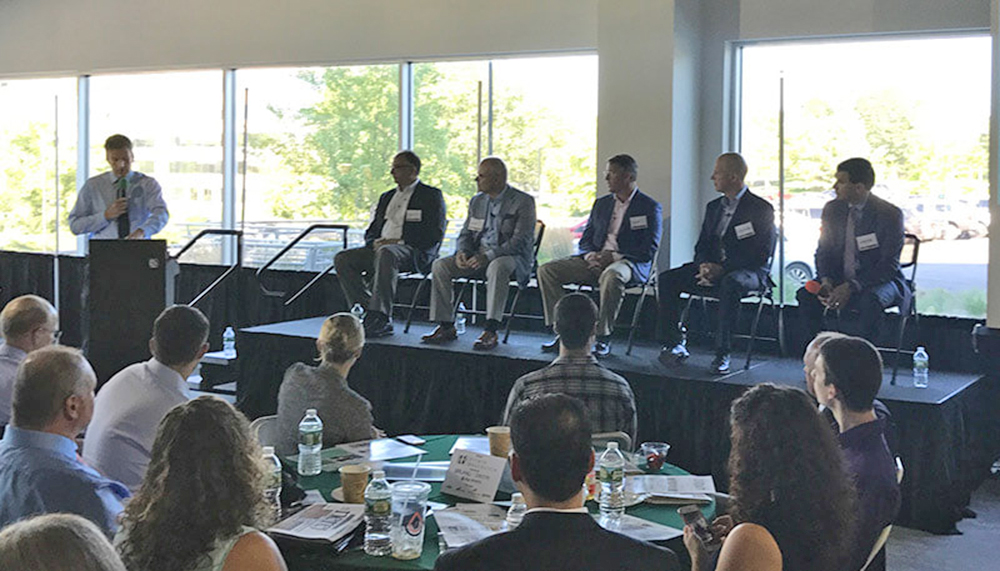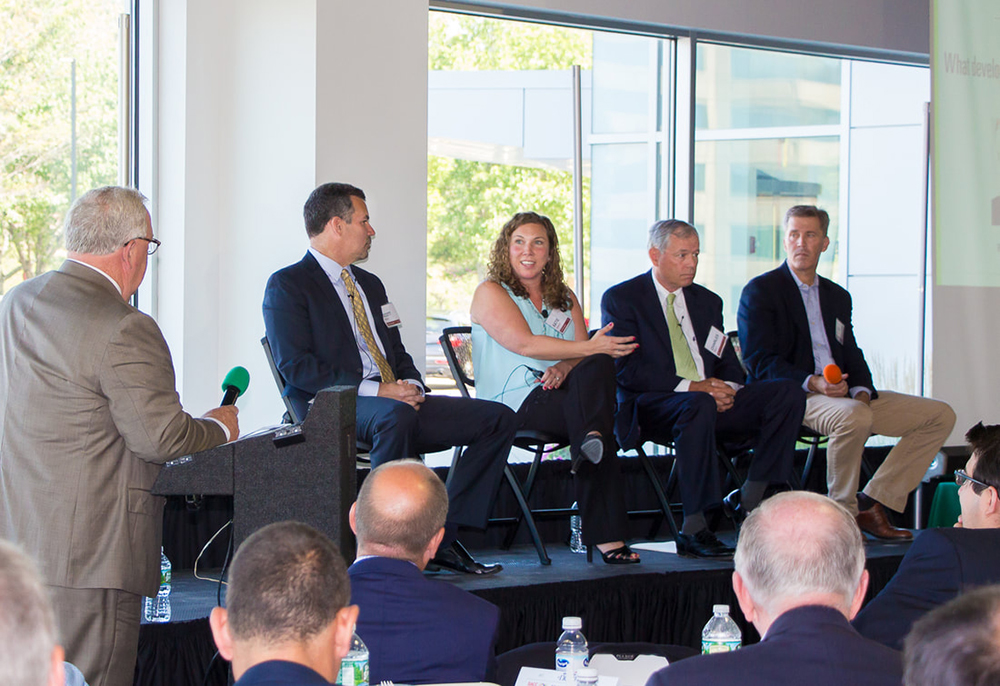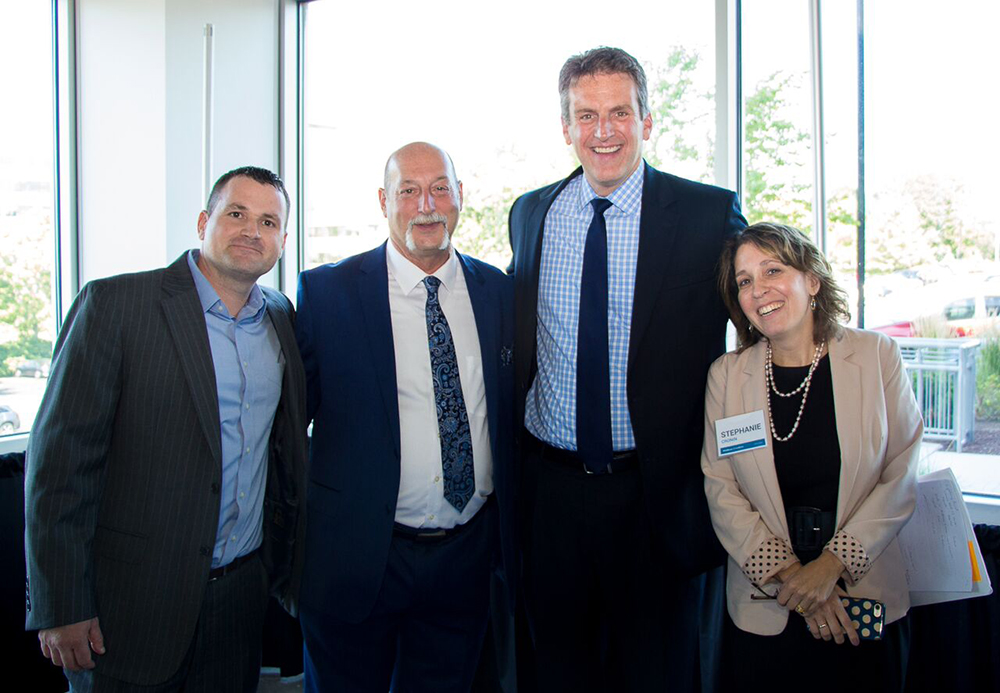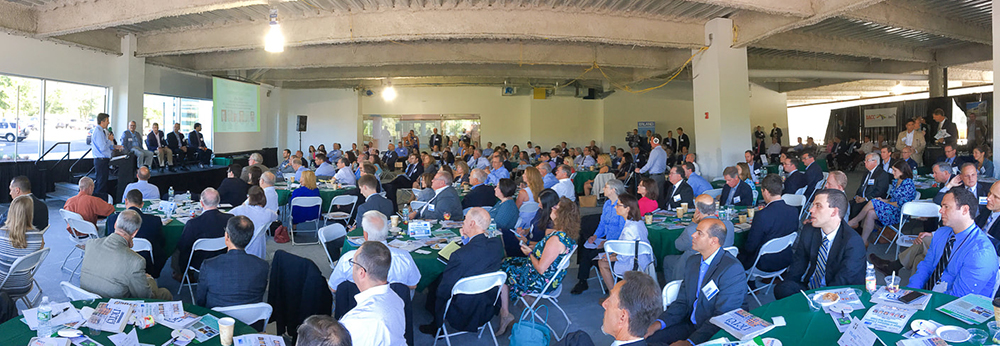Burlington, MA The New England Real Estate Journal (NEREJ), in conjunction with the Middlesex 3 Coalition, a regional partnership of nine Middlesex County communities, hosted a morning of panel discussions designed to highlight the area’s emergence as a tech and life science corridor while also addressing the challenges facing the region. Held at The Gutierrez Company’s recently constructed 4 Burlington Woods, the program, “The Future of Middlesex 3 Coalition Commercial Real Estate” examined the factors that are encouraging firms like MilliporeSigma (formerly EMD Millipore) and Kronos to make long term commitments to the region while exploring ways to encourage further development along Rte. 3.

Commonwealth of Massachusetts; Paul Asmar,
MilliporeSigma; John Boyle, Cushman & Wakefield;
Mark Reardon, CBRE/New England; Jonathan Proffitt,
Kronos; and Andrew Gallinaro, National Development.
The first panel was moderated by Jay Ash, secretary of housing and economic development for the Commonwealth of Massachusetts, and included Paul Asmar, head of real estate and property services at MilliporeSigma, whose firm will move into a 350,000 s/f build-to-suit facility currently under construction by The Gutierrez Company. John Boyle, vice chairman of Cushman & Wakefield, whose firm negotiated the 12-year, 505,000 s/f lease allowingKronos to relocate and consolidate its operations at Crosspoint in Lowell; Jonathan Proffitt, senior director of global real estate and facilities at Kronos; Mark Reardon, executive vice president/partner at CBRE/New England, which represents Anchorline Partners, the owner of the 1.2 million s/f Crosspoint; and Andrew Gallinaro, senior vice president of asset and property management at National Development, which revitalized the aging former New England Executive Park to create amenity-rich The District Burlington.
When asked to identify the trends that are emerging in the market, Boyle began by re-iterating that firms are still seeking vibrant and active work environments in suburban locations that are typically associated with Boston/Cambridge–real estate with “a vibe” that includes walkable amenities such as bars and restaurants – and pointed to The District and Crosspoint as prime examples. Boyle added that the most impactful recent trend is the massive influx of life science firms migrating to the Commonwealth.
“In my 32 years in the business, I’ve never seen anything like it,” he said. And while many firms want to be in Kendall Sq., space is scarce, and rents for class A office and lab space are topping the $80 per s/f mark. “[Burlington] may not have the cache [of Kendall]…but if you can’t find real estate and you need real estate, I think you’re going to see more and more companies-like (Millipore) will see that Burlington and Route 3 really works.”
Reardon said that the Rte. 3 corridor is in a state of transition, explaining that when the computer and telecommunications industries that dominated the area 25-30 years ago began to fade, there was no single industry that came in and filled up the existing building stock. “What we’re experiencing now, is that there is more diversity in terms of the companies that are out there,” and he cited not only Millipore but a number of tech and life science tenants now filling space. “We’re still in a period of time where we’re transitioning–which will be very powerful in the years to come, and it’s going to take a little bit of pain and suffering to get there, but it will be a better place when it’s done,” he said.

Riemer & Braunstein LLP; Scott Weiss, The Gutierrez Co.;
Katie Enright, Howard Stein Hudson; Chuck Reilly, Dacon;
and Todd Fremont-Smith, Nordblom.
Gallinaro addressed one of the issues affecting the area’s ability to attract companies, the perception that Boston/Cambridge and the nearby suburbs are two distinct markets, rather than part of one Metropolitan Statistical Area (MSA) comparable in size to many of the country’s large cities. “We like to refer to Burlington as the inner suburban ring, and to position ourselves (The District) as really connected to the city, given its close proximity to Logan airport,” he said.
Bob Buckley, senior partner at Riemer & Braunstein LLP, moderated the second panel, which focused on the efforts that property owners and developers are making to attract companies. The panel included Scott Weiss, vice president of development at The Gutierrez Co.; Katie Enright, P.E., manager of land development at engineering firm Howard Stein Hudson’s Chelmsford office and a member of the Middlesex 3 Coalition’s board of directors; Chuck Reilly, vice president of business development at construction firm Dacon; and Todd Fremont-Smith, senior vice president and director of mixed-use projects at Nordblom, which constructed one of the region’s premiere retail destinations Third Ave., as part of their repositioning of Northwest Park.

Rick Kaplan, NEREJ; Jay Ash, Commonwealth of
Massachusetts; and Stephanie Cronin,
Middlesex 3 Coalition.
One of the issues facing the Rte. 3 Coalition businesses in competing for talent is the limited transportation options for potential employees. The much sought after millennial workforce is less likely to own cars, so there needs to be a wider array of transportation modes for employees coming in from the urban areas. So while there are commuter rail connections from North Station to Woburn (Anderson Station) and Lowell, and bus lines running from Alewife Station in Cambridge to various points in the region, Buckley says that the “last mile” from major transportation nodes to the workplace is something that the Coalition’s Transportation Management Association is making great strides in improving. “I think that once we get a handle on it, we’re going to start to see some real tangible results over the next couple of years,” he said.
Another challenge for the region is convincing the various municipalities to allow zoning and permitting changes to allow for development that may contribute to a better quality of life for its residents. “Change is scary,” said Weiss, who in addition to being a developer, has also been a planning board member in his own community and understands the apprehension that a town’s residents experience when new developments are being planned, such as traffic concerns. “Growth is important to a community and you really have a choice…if you don’t build [the development], it just goes up the street and you get the traffic without any of the tax benefits, or worse yet, it goes to a distant community. Then you have empty roads and no jobs and a lot of people suffering. So from where I sit, the challenge is to be able to plan responsibly and work together with the communities that you’re involved in.”









